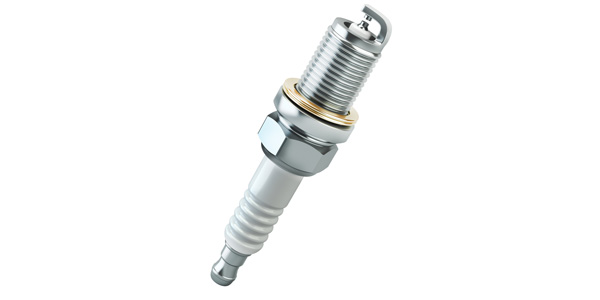
Most late-model vehicles will only require one or maybe two sets of spark plugs during their lifetime. Long-life platinum and iridium spark plugs usually last upward of 100,000 miles under normal operating conditions.
On older vehicles that were factory- equipped with standard spark plugs, the plugs may only last 35,000 to 50,000 miles. The iron/nickel alloy electrodes on standard plugs wear at a much faster rate than those on platinum or iridium plugs. As the electrodes erode, the gap between the center and side electrodes widens and increases the voltage required to create a spark when the plug fires. Eventually, the point is reached where the voltage required to fire the plug exceeds the output capacity of the coil and the plug fails to fire. Misfires cause a loss of power and fuel economy, and significantly increase unburned hydrocarbon (HC) emissions in the exhaust. If a plug continues to misfire for a prolonged period of time, it may overheat and damage the catalytic converter.
Plug wear and elevated firing voltages also may overheat and damage the ignition coil, especially on Coil-On-Plug (COP) ignition systems. The long plastic boot that fits down over the spark plug on a COP coil may get so hot that it actually melts!
On 1996 and newer vehicles with OBD II, spark plug misfires will set off a trouble code and turn on the “Check Engine” light. A vehicle will not pass an OBD II plug-in emissions test if it has an illuminated “Check Engine” light.
Follow your supplier’s application listings or cross-reference chart when looking up spark plugs for a customer’s vehicle. Although many customers prefer to stick with the original brand of spark plug, replacement plugs do not have to be the same brand as the original as long as they fit and function the same. Plug manufacturers compare competitive plugs against their own to make sure their plugs fit correctly and perform the same (or better) as the original plugs. If there is no cross-reference for a particular plug, it means the supplier does not have a close enough match.
Replacement spark plugs must be the same size as the original (same hex size, diameter, thread pitch and length), and have a similar “heat range” (hot enough to resist fouling when the plug is cold, and cool enough to resist pre-ignition when the plug is hot). Electrode number and configurations may sometimes vary, but the “reach” (how far the tip extends into the combustion chamber) and gap should be similar to the original. Although all plugs come pre-gapped from the factory, gap should always be measured and adjusted as needed before the plugs are installed.
Spark plugs are almost always replaced in complete sets, unless a single low-mileage plug has fouled because of oil entering the combustion chamber (worn or broken piston rings, worn valve guides or worn valve guide seals) or a leaky head gasket (coolant fouling).
Standard plugs can be upgraded to platinum or iridium long-life plugs, but downgrading from platinum or iridium to standard plugs to save a few bucks is hardly worth it – especially if the plugs are difficult to change. Recommend the long-life plugs so your customer won’t have to change them again for another 100,000 miles.
On applications that have plug wires, the wires and boots should be inspected for carbon tracks, burning or damage. Boots must fit securely on the plugs and coil terminals. If only one or two plug wires are bad, recommend replacing the entire set, because chances are the other wires also are failing. Advise your customer to change the wires one at a time to avoid mixing up the firing order.











